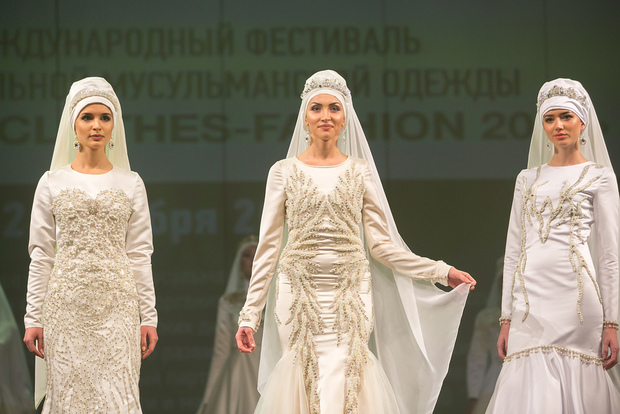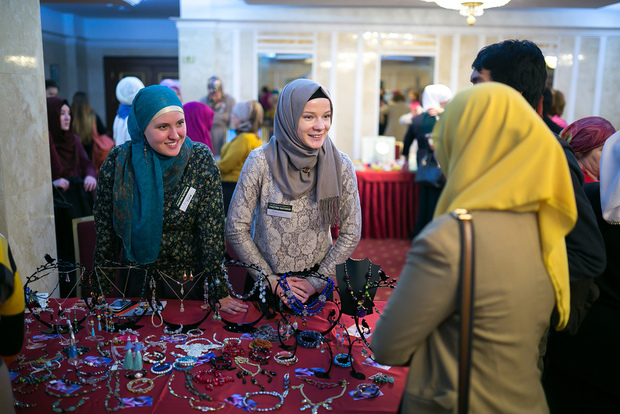Modern Tatar style: ‘conflict of versions’ of hijab and rich fantasy of pop singers
Fashion à la Tatar: traditions and modernity in the Era of Consumption. Part 2
The influence of the religion on the look of the people living in Tatar cities and villages becomes more noticeable every year. Orienting to co-religionists from Turkey and the Arab East, the Tatar women are trying to combine canons of Sharia and wearing a hijab with national elements. Even those women who are far from Islam put corresponding clothes on for their Muslim marriage. Kazan ethnographer Dina Gatina-Shafikova continues to tell about the influence of the religion and national traditions on the look of modern Tatar people in her new column in Realnoe Vremya. Today she speaks about the clothes of practising Muslim women and theatrical and pop tackiness.
Oh, wedding…
Today not every Tatar woman is ready to cover her head on a permanent basis. However, a Tatar and Muslim woman has especial days and occasions when she, undoubtedly, does it (name-giving, Muslim marriage called Nikah, wake, iftars, etc.). In other words, it is obligatory to do it in a religious event in family or in public, in spite of the fact that the use of such a marker in everyday life is an unusual or incorrect thing for an ordinary person.
Women's festive clothes are not used on a daily basis but quite rarely, possibly once in life. Consequently, people choose them with all due responsibility. Wedding is one of the important events in a girl or woman's life. Wedding fashion is another 'book' that has its own rules. It takes into account both fashion trends and religious preferences of the woman who is wearing the dress. Earlier dresses or suits completely covering the neck, arms till hands and feet were sewed or bought only for Nikah. And nowadays one can see it at an ordinary wedding ceremony where the newly-wed couple is close to Islam. Brides often use motives of the traditional Tatar costume for a Nikah dress. So they pay tribute to their ancestors. Woman's costume of the end of the 19th and beginning of the 20thcentury is taken as a model: it is a long-sleeve dress adorned with embroidery and has frills. An imitation of izu (woman's upper piece of clothing on the chest) can also be used. The head is covered with a headscarf that can have decorative elements like kalfak fastened with pins. Variations may be different. It depends on the taste and wishes of a client. Such dresses are not on the market. They are sewed on demand.
All the above-mentioned description is a product typical of a Tatar woman who respects her history and is ready to use an especial marker in her clothing to define her national identity and make her noticeable in the crowd.
However, there is another segment of the Tatar woman's fashion that is a characteristic of practising Muslims. It is sometimes absolutely different from an ordinary urban citizen's clothes.

'Conflict of versions' of Muslim dress
First of all, a practising Tatar and Muslim woman covers her head, neck, puts some clothes that cover her arms till wrists and feet in everyday life or being among unknown men. Because of different factors (political, cultural, etc.), such clothes were a characteristic of a small group of people (old women, cleric's wives) in the Soviet era. So, the expression of religion almost existed. As it is known, national clothes are inextricably linked with religious views. Consequently, entire generations lost the connection with the tradition culture that resulted in a misunderstanding between those people who came to religion and changed their clothes.
Initially, due to the absence of a dress corresponding to religious views, many Muslim women followed general Muslim fashion. In the 1990-2000s, the consumer market was forming. Going to study to Turkey, Egypt and other countries, many men returned not only with knowledge but also an outlook on what clothes a Muslim should wear, but often without paying attention to the national aspect. Just 3 years ago one activist of the Tatar Youth Movement told they are told off because they were wearing wrong clothes. She reasonably noted: 'So teach and show how we should wear headdresses and traditional Tatar clothes. Then they will get accustomed to such forms and take into account the time and specifics'.
At present many practising Tatar women began to skillfully use elements of both Muslim and European fashion and did not forget about the traditional Tatar costume.
However, there are pitfalls in the Tatar and Islamic fashion. More orthodox Muslim women are for relaxed fit dresses and shirts (hiding the silhouette of their figure) and against trousers or jeans and fitted clothes. So many practising Tatar women criticise them because they don't follow what was said above but want to adorn themselves in an excessive way. The difference of opinions on how to wear clothes leads to certain quarrels between the groups. They say Islamic canons must be followed, while the others think the time is changing, and Islam is not a dead construction, it is also developing and changing. So, they follow the key rules of how to wear clothes without excessive nudity, borrowing just some adopted details from clothes that give them an opportunity to live a modern lifestyle.

Theatrical and pop tackiness
Theatrical costume is another story. A costume has its own life on the stage. It is created according to certain rules – it must be both comfortable for a performer and emphasise the dramatic character. In classical ballet, opera or theatrical staging, the main and known elements will be borrowed, the rest of the details will be thrown away. Art expert Donina L.N. dedicated many articles and a monograph to the Tatar costume on the stage. The author told about the history, problems of interpretation and reconstruction of the Tatar theatrical costume.
Pop culture is another side of the theatrical character. Rich fantasy of the author of a costume who has his or her own interpretation, taste, style and knowledge of the traditional culture of the Tatar people sometimes creates awful characters whose clothes consist of the elements that cannot be combined with each other.
Many Tatar pop singers think the use of national motives is their duty. Then costumes consisting of baggy trousers and shortened dresses spangled with sequins and crystals with a small and probably decorative headdress. The list can be continued where each new detail will be more exaggerative and turning into tackiness.
Unfortunately, because of a long period of the absence of any information, people thought the clothes showed on the stage were traditional. Consequently, the clothes of pop singers started to dominate and substitute the original Tatar national costume. There have been published many reconstructions where scientists and professional artists created historically proved costumes. Museums regularly host different exhibitions where not only the collections of local museums but also the Tatar clothes of the 19th and the beginning of the 20th century brought from other regions are demonstrated. This is why it is up to us whether we want to know the original Tatar material culture or ready to receive a processed product.

So, the Tatar fashion exists. It is developing and growing together with the people who wear such clothes. A modern buyer is ready to not only spend time in order to get knowledge about their nation but also spend money on a product that was made according to original Tatar motives.